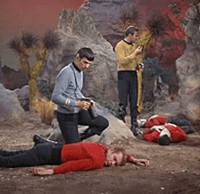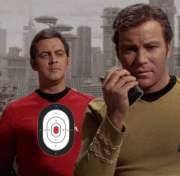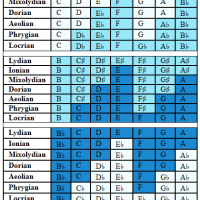 I just finished reading Redshirts, by John Scalzi, and it’s just about the best, most entertaining, brilliant story I’ve read in a good long time. It’s so good that I have to place it with other best-of-kind laugh out loud science fiction delights such as Galaxy Quest and Hitchhiker’s Guide to the Galaxy.
I just finished reading Redshirts, by John Scalzi, and it’s just about the best, most entertaining, brilliant story I’ve read in a good long time. It’s so good that I have to place it with other best-of-kind laugh out loud science fiction delights such as Galaxy Quest and Hitchhiker’s Guide to the Galaxy.
It has a lot in common with Galaxy Quest in being a multi-level utterly ingenious send up and hysterical deconstruction of Star Trek (The Original Series). Scalzi has captured and lampshaded so many of the things fans have discussed over the years. And, as with Galaxy Quest, it’s a pretty good story all on its own.
But it is an absolute must-read for any fan of the original Star Trek.
The title, Redshirts, says a lot of what the story is about. Imagine if the ensigns onboard the Enterprise began to realize their predicament — that being on an away mission was likely to be certain death.
Imagine further that they come to recognize that on this particular ship, the Intrepid, flagship of the Universal Union (the “Dub U”), the death rate was particularly high — more so than any other ship in the Union.
The Union acknowledges the death rate but says it’s all due to the Intrepid being the flagship and therefore being given the riskier missions. (But analysis shows that other ships, such as combat and infiltration ships, actually have riskier missions and lower death rates.)
Nor does it seem due to bad decisions or incompetence by the ship’s officers. It’s just that away missions always seem to go bad, and it’s always the lowly crew members who suffer the fatal consequences. The ship’s officers escape certain death time and again.
Except for poor Lieutenant Kerensky, the ship’s astrogator, who seems to suffer terrible life-threatening injuries on so many away missions, but always manages to survive and heal in time for the next mission.
(One might even question why the ship’s astrogator is even sent on these dangerous away missions. The poor guy would much rather just astrogate.)
§
 I’m a little stuck here in that saying much more about the plot would really spoil several key reveals about what’s going on. (I may already have said too much.)
I’m a little stuck here in that saying much more about the plot would really spoil several key reveals about what’s going on. (I may already have said too much.)
I will just say the story gets seriously and delightfully meta.
I’ll add that, as also with Galaxy Quest, the story has surprising depth, wonderful texture, and touching emotional resonance.
The ending may just bring a tear to your eye (it sure did mine).
Laugh out loud funny, brilliant meta, and emotionally rich. That’s some damn fine writing. I pretty much gulped the entire book down in one sitting.
(I’m going to have to check out some other books by Scalzi. Some may know him as a creative consultant for Stargate Universe. I disliked the original Stargate movie so much I ignored the various TV versions, but I may have to check that one out. It only ran 40 episodes, which probably means it was pretty good.)
§
I really don’t want to spoil anything, and I would recommend actively avoiding any review or article that gives away the plot. You really do want this to unfold before you.
There are some things I can safely share, though.
The main officers aboard the Intrepid are:
- Captain Lucius Abernathy
- Science Officer Q’eeng
- Lieutenant Anatoly Kerensky (astrogator)
- Chief Engineer Paul West
- Chief Medical Officer Hartnell
Who are instantly recognizable as Kirk, Spock, Chekov, Scotty, and Bones, respectively. (Unless I missed them, Uhura and Sulu are missing. I’m going to re-read this immediately — it’s that good — and I’ll look for them.)
However, in this story, those are all supporting characters. The actual main characters are:
- Ensign Andrew Dahl
- Ensign Maia Duvall
- Ensign James Albert Hanson the Fourth
- Ensign Finn
- Ensign (Jasper) Hester
Redshirts all and newly assigned to the Intrepid.
On their first day of duty, they already begin to notice how the crew tend to avoid contact with the officers, often fleeing the room on some pretense just before an officer arrives.
§
 It gets weirder, and I’ll share one early bit with you to demonstrate just how weird (and wonderful).
It gets weirder, and I’ll share one early bit with you to demonstrate just how weird (and wonderful).
Ensign Dahl is assigned to the science lab. One day Captain Abernathy and Science Officer Q’eeng come through the door (everyone else had, for various seemingly legitimate reasons, left the room just moments earlier).
They tell Dahl that the planet they’re currently orbiting is experiencing a global plague. A covert two-person team was sent to collect samples, but both members became infected. Ensign Lee is already dead.
“Damn plague liquefied the flesh right off her bones,” Abernathy said, grimly.
“The other Intrepid crew member infected is Lieutenant Kerensky,” Q’eeng said. At this, both Abernathy and Q’eeng looked at Dahl intensely, as if to stress the sheer, abject horror of this Lieutenant Kerensky being infected.
“Oh, no,” Dahl ventured. “Not Kerensky.”
Dahl is given the task of developing a “counter-bacterial,” and he is given only six hours to do so.
Once the officers leave, Dahl’s co-workers return and quiz him about the situation. Then they introduce him to the Box.
Which looks like a microwave oven (complete with rotating turntable). It has three buttons on it: The green one starts it; the red one stops it; and the white one opens the door.
“That’s it? ‘The Box’?” Dahl said.
“If it makes you feel better to think it’s an experimental quantum-based computer with advanced inductive artificial intelligence capacity, whose design comes to us from an advanced but extinct race of warrior-engineers, then you can think about it that way,” Collins said.
“Is that actually what it is?” Dahl asked.
“Sure,” Collins said, and handed the vial to Dahl. “Put this in the Box.”
It turns out that, in the current circumstances, the Box needs five-and-a-half hours to find a solution. When it’s done, it goes ding. And sends its results to Dahl’s work tablet.
Dahl grabbed his work tablet and powered up the screen. On it was a rotating picture of a complex organic molecule and beside that, a long scrolling column of data. Dahl tried to read it.
“It’s giving me gibberish,” he said, after a minute. “Long streaming columns of it.”
“You’re fine,” Trin said. He set down his own work and walked over to Dahl. “Now, listen closely. Here’s what you do next. First, you’re going to take your work table to the bridge, where Q’eeng is.”
“Why?” Dahl said. “I could just mail the data to him.”
Trin shook his head. “It’s not how this works.”
It turns out that, upon presenting the data to Q’eeng, Dahl is supposed to say they’ve nearly got it, but the protein coat is giving them a problem. (Or say it’s enzyme transcription errors or that the RNA replication is buggy. It’s just that “protein coat” is easier to say.)
Q’eeng will immediately spot the error, offer a small admonishment to the crew member, fix the data, and transfer it to the ship’s computer, so it can replicate the counter-bacterial and save Kerensky’s life.
(And despite his brush with death, Karensky will be tip-top by the next away mission.)
Of course, any fan of the old Star Trek show will immediately recognize both the magical box and the protocol involved. We’ve seen it many times.
Astute readers may already begin to tumble to what’s going on here. I’ll say no more.
§ §
One of the great things about Galaxy Quest is that it works on three levels:
- It’s a great standalone SF comedy.
- It’s a hysterical send up of Star Trek: The Original Series.
- It’s a love letter to Star Trek fans (and SF fans in general).
Scalzi’s Redshirts also works on those same multiple levels. It’s a damn funny (and brilliant) SF story on its own, but the Star Trek factor takes it to awesome heights, both as a send up and as a love letter.
Seriously, if you loved Star Trek, you have to read this book!
And, as I said above, it ends with some pretty deep thoughts, and, for all its fun and parody, manages to also be deeply touching.
It definitely rates an unqualified strong Wow!
Stay meta, my friends!
∇













September 28th, 2019 at 10:28 am
“I just finished reading Redshirts,…”
That sounds weird now, because I finished it last Sunday and wrote the post early last week. I meant to read the book again (and edit the post a bit), but my electrical issues ended up taking center stage most of the week.
IMPORTANT NOTE: I would urge readers to ignore any reviews or descriptions of the book so as to avoid any spoilers. Even a full list of the cast of characters will give away certain key plot points!
But when you have read it, the TV Tropes site has a good article that goes through a lot of the references.
September 28th, 2019 at 7:00 pm
I’ve been a John Scalzi fan for years. I like the way he writes: lean, unpretentious, and without taking himself too seriously. Redshirts is excellent. Others similar in feel are Fuzzy Nation and The Android’s Dream. His Old Man’s war series is also worth checking out.
When reading Redshirts, as the story developed, I wondered just how meta he was going to get. The final scene, of course, answered that.
I do have a couple of beefs with his stories. His male characters mostly sound like John Scalzi talking with himself, and I suspect his female characters seem the same, probably like his wife and daughter. And his endings often wrap up a little to quickly and neatly, a consequence of him being a pantser. But these aren’t enough to stop me reading his stuff.
September 28th, 2019 at 7:13 pm
“The final scene, of course, answered that.”
Yeah, and pretty obvious who Hanson is. (Or is that what you meant, rather than the penultimate and ultimate chapters? Which were really funny.)
“And his endings often wrap up a little to quickly and neatly,”
Even Redshirts is kind of that way, although it didn’t bother me. On some level, I didn’t want the story to end, but on another, he’d done what he set out to do, and I can’t think where else he could take it.
One review I read pointed out how the structure tricks you. You can’t use the length of the book as a clue. (It’s surprising how useful it can be knowing, for instance, there are just 10 pages left to a story.)
I’m definitely going to check out his other works (once I get through my reading list). I’ll start with the two you recommended.
September 28th, 2019 at 7:36 pm
You made me pull up my Kindle version, but yeah, Hanson at the end of the main narrative. I’d forgotten about the codas, which were cute. I’d also forgotten about the very end of the main narrative and the very short final chapter.
He’s got two series going on right now, the Lock In books, and the Interdependency. The Lock In ones, near future crime drama, seem like he’s more into than the Interdependency ones, which I get the feel he’s writing because he’s expected to put out space opera, although they’re still quite readable.
September 28th, 2019 at 7:53 pm
I loved the Codas! Their titles have dual meanings, and the text reflects both of them.
The Lock In series sounds interesting. I always liked sf crime stories.
December 31st, 2020 at 11:05 am
[…] can redeem the post now that I’ve read The Android’s Dream (2006), by John Scalzi (whom I’ve praised here before for Redshirts). Here, too, is an extremely competent protagonist in an action hero thriller. (As an […]
February 6th, 2021 at 10:04 am
[…] thoroughly enjoyed the first John Scalzi book I read, Redshirts. I thought it was delightful and definitely my kind of book. I also very much enjoyed the second […]